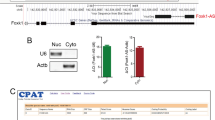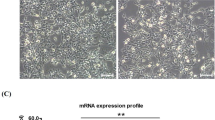Abstract
The Pax3 gene has been proven to play a crucial role in determining myogenic progenitor cell fate during embryonic myogenesis; however, the molecular role of Pax3 in myoblast development during later stages of myogenesis is unknown. We hypothesized that Pax3 would function in myoblast proliferation and differentiation; therefore, we employed three short hairpin RNAs (shRNAs) (shRNA1, shRNA2, and shRNA3) that target Pax3 to characterize the function of Pax3 in duck myoblast development. The mRNA and protein expression levels of Pax3 in duck myoblasts were detected using real-time PCR and Western blotting. Cell proliferation was assessed using the MTT and BrdU assays, while cell differentiation was assayed using immunofluorescence labeling with a MyoG antibody. Additionally, folic acid (FA), which is a rescue tool, was added into the medium of duck myoblasts to indirectly examine the function of Pax3 on duck myoblast proliferation and differentiation. The results revealed that one of the shRNA vectors, shRNA1, could significantly and stably reduce the expression of Pax3 (P < 0.05). Silencing Pax3 by shRNA1 significantly reduced the proliferation and differentiation of duck myoblasts (P < 0.05) due to downregulated expression of myogenic regulator factors. These trends could be rescued by adding FA; and Pax7, a paralog gene of Pax3, was involved in those processes. Overall, Pax3 had a positive function in duck myoblast proliferation and differentiation by modulating the expression of myogenic regulation factors, and shRNA targeting of Pax3 might be a new approach for understanding the function of Pax3 in the development of diverse tissues.





Similar content being viewed by others
References
Buckingham M, Relaix F (2007) The role of Pax genes in the development of tissues and organs: Pax3 and Pax7 regulate muscle progenitor cell functions. Annu Rev Cell Dev Biol 23:645–673
Chi N, Epstein JA (2002) Getting your Pax straight: Pax proteins in development and disease. Trends Genet 18:41–47
Young AP, Wagers AJ (2010) Pax3 induces differentiation of juvenile skeletal muscle stem cells without transcriptional upregulation of canonical myogenic regulatory factors. J Cell Sci 123:2632–2639
Tremblay P, Gruss P (1994) Pax: genes for mice and men. Pharmacol Ther 61:205–226
Koblar SA, Murphy M, Barrett GL, Underhill A, Gros P, Bartlett PF (1999) Pax‐3 regulates neurogenesis in neural crest‐derived precursor cells. J Neurosci Res 56:518–530
Kuang S, Chargé SB, Seale P, Huh M, Rudnicki MA (2006) Distinct roles for Pax7 and Pax3 in adult regenerative myogenesis. J Cell Biol 172:103–113
Williams BA, Ordahl CP (1994) Pax-3 expression in segmental mesoderm marks early stages in myogenic cell specification. Development 120:785–796
Buckingham M, Bajard L, Chang T, Daubas P, Hadchouel J, Meilhac S, Montarras D, Rocancourt D, Relaix F (2003) The formation of skeletal muscle: from somite to limb. J Anat 202:59–68
Henderson DJ, Conway SJ, Copp AJ (1999) Rib Truncations and Fusions in the Sp2H mouse reveal a role for Pax3 in specification of the ventro-lateral and posterior parts of the somite. Dev Biol 209:143–158
Seale P, Sabourin LA, Girgis-Gabardo A, Mansouri A, Gruss P, Rudnicki MA (2000) Pax7 is required for the specification of myogenic satellite cells. Cell 102:777–786
Goulding M, Lumsden A, Paquette AJ (1994) Regulation of Pax-3 expression in the dermomyotome and its role in muscle development. Development 120:957–971
Bober E, Franz T, Arnold H-H, Gruss P, Tremblay P (1994) Pax-3 is required for the development of limb muscles: a possible role for the migration of dermomyotomal muscle progenitor cells. Development 120:603–612
Tajbakhsh S, Rocancourt D, Cossu G, Buckingham M (1997) Redefining the Genetic Hierarchies Controlling Skeletal Myogenesis: Pax-3 and Myf-5 Act Upstream of MyoD. Cell 89:127–138
Braun T, Gautel M (2011) Transcriptional mechanisms regulating skeletal muscle differentiation, growth and homeostasis. Nat Rev Mol Cell Biol 12:349–361
Maroto M, Reshef R, Münsterberg AE, Koester S, Goulding M, Lassar AB (1997) Ectopic Pax-3 activates MyoD and Myf-5 expression in embryonic mesoderm and neural tissue. Cell 89:139–148
Mennerich D, Braun T (2001) Activation of myogenesis by the homeobox gene Lbx1 requires cell proliferation. EMBO J 20:7174–7183
Darabi R, Santos FN, Filareto A, Pan W, Koene R, Rudnicki MA, Kyba M, Perlingeiro RC (2011) Assessment of the myogenic stem cell compartment following transplantation of Pax3/Pax7‐induced embryonic stem cell‐derived progenitors. Stem cells 29:777–790
Birchmeier C, Brohmann H (2000) Genes that control the development of migrating muscle precursor cells. Curr Opin Cell Biol 12:725–730
Relaix F, Rocancourt D, Mansouri A, Buckingham M (2004) Divergent functions of murine Pax3 and Pax7 in limb muscle development. Genes Dev 18:1088–1105
Brzóska E, Przewoźniak M, Grabowska I, Jańczyk‐Ilach K, Moraczewski J (2009) Pax3 and Pax7 expression during myoblast differentiation in vitro and fast and slow muscle regeneration in vivo. Cell Biol Int 33:483–492
Ichi S, Nakazaki H, Boshnjaku V, Singh RM, Mania-Farnell B, Xi G, McLone DG, Tomita T, Mayanil CSK (2011) Fetal neural tube stem cells from Pax3 mutant mice proliferate, differentiate, and form synaptic connections when stimulated with folic acid. Stem Cells Dev 21:321–330
Wlodarczyk BJ, Tang LS, Triplett A, Aleman F, Finnell RH (2006) Spontaneous neural tube defects in splotch mice supplemented with selected micronutrients. Toxicol Appl Pharmacol 213:55–63
Burren KA, Savery D, Massa V, Kok RM, Scott JM, Blom HJ, Copp AJ, Greene ND (2008) Gene-environment interactions in the causation of neural tube defects: folate deficiency increases susceptibility conferred by loss of Pax3 function. Hum Mol Genet 17:3675–3685
Liu H-h, Li L, Chen X, Cao W, Zhang R-p, Yu H-y, Xu F, He H, Wang J-w (2011) Characterization of in vitro cultured myoblasts isolated from duck (Anas platyrhynchos) embryo. Cytotechnology 63:399–406
Pfaffl MW (2001) A new mathematical model for relative quantification in real-time RT-PCR. Nucleic Acids Res 29:e45
Borycki A, Li J, Jin F, Emerson C, Epstein J (1999) Pax3 functions in cell survival and in pax7 regulation. Development 126:1665–1674
Tripathi AK, Aparnathi MK, Vyavahare SS, Ramani UV, Rank DN, Joshi CG (2012) Myostatin gene silencing by RNA interference in chicken embryo fibroblast cells. J Biotechnol 160:140–145
Stewart CK, Li J, Golovan SP (2008) Adverse effects induced by short hairpin RNA expression in porcine fetal fibroblasts. Biochem Biophys Res Commun 370:113–117
Bhagavati S, Song X, Siddiqui M (2007) RNAi inhibition of Pax3/7 expression leads to markedly decreased expression of muscle determination genes. Mol Cell Biochem 302:257–262
Cornelison D, Wold BJ (1997) Single-cell analysis of regulatory gene expression in quiescent and activated mouse skeletal muscle satellite cells. Dev Biol 191:270–283
Olguín HC, Pisconti A (2012) Marking the tempo for myogenesis: pax7 and the regulation of muscle stem cell fate decisions. J Cell Mol Med 16:1013–1025
Zammit PS, Relaix F, Nagata Y, Ruiz AP, Collins CA, Partridge TA, Beauchamp JR (2006) Pax7 and myogenic progression in skeletal muscle satellite cells. J Cell Sci 119:1824–1832
Olguin HC, Olwin BB (2004) Pax-7 up-regulation inhibits myogenesis and cell cycle progression in satellite cells: a potential mechanism for self-renewal. Dev Biol 275:375–388
Relaix F, Rocancourt D, Mansouri A, Buckingham M (2005) A Pax3/Pax7-dependent population of skeletal muscle progenitor cells. Nature 435:948–953
Acknowledgments
This work was supported by the Chinese Agriculture Research Service (No.CARS-43-6) and the Breeding of Multiple Crossbreeding System in waterfowl (2011NZ0099-8).
Author information
Authors and Affiliations
Corresponding author
Rights and permissions
About this article
Cite this article
Zhang, RP., Liu, HH., Wang, HH. et al. Silencing Pax3 by shRNA inhibits the proliferation and differentiation of duck (Anas platyrhynchos) myoblasts. Mol Cell Biochem 386, 211–222 (2014). https://doi.org/10.1007/s11010-013-1859-4
Received:
Accepted:
Published:
Issue Date:
DOI: https://doi.org/10.1007/s11010-013-1859-4




